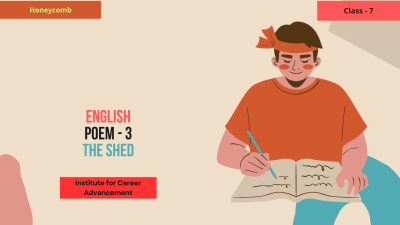| Short description |
"The Shed" is a poem by Frank Flynn that evokes a sense of mystery and intrigue. It describes an old, neglected shed in a garden, with a creaking door and a dusty window. The poet imagines strange creatures and ghostly figures lurking within, creating a sense of suspense and curiosity. It's a captivating exploration of childhood imagination and the allure of the unknown.
"দ্য শেড" ফ্রাঙ্ক ফ্লিনের একটি কবিতা যা রহস্য এবং চক্রান্তের অনুভূতি জাগিয়ে তোলে। এটি একটি বাগানের একটি পুরানো, অবহেলিত ছাউনির বর্ণনা দেয়, যার একটি ভেঙে পড়া দরজা এবং একটি ধুলোময় জানালা রয়েছে। কবি অদ্ভুত প্রাণী এবং ভিতরে লুকিয়ে থাকা ভূতের মূর্তিগুলি কল্পনা করেন, যা একটি রহস্য এবং কৌতূহলের অনুভূতি তৈরি করে। এটি শৈশবের কল্পনা এবং অজানা আকর্ষণের একটি চিত্তাকর্ষক অন্বেষণ। |
|
|
| Outcomes |
- By the end of the lesson, students should be able to: 1. Understanding the Theme Identify and explain the central theme of the poem, which revolves around curiosity and the fear of the unknown. Discuss how the shed symbolizes the unknown, illustrating the tension between the urge to explore and the fear of what might be inside. 2. Analyzing Imagery and Language Recognize and analyze the imagery used in the poem, understanding how words like “dark,” “quiet,” and “abandoned” contribute to the sense of mystery and fear. Understand how the poet’s choice of descriptive language helps to build an eerie atmosphere and conveys the feelings of uncertainty and curiosity. 3. Exploring the Role of Imagination Examine how the speaker’s imagination fills the shed with mystery, creating a psychological barrier that prevents them from entering it. Reflect on the connection between imagination and fear, discussing how imagination can amplify feelings of fear about things we don’t fully understand. 4. Developing Emotional Understanding Empathize with the speaker’s feelings of fear and curiosity, recognizing these emotions as common experiences in childhood. Understand the complexity of fear and curiosity, and how they often coexist when facing unfamiliar or unexplored things. 5. Enhancing Vocabulary and Language Skills Learn new vocabulary related to fear, curiosity, and imagination, such as "mysterious," "abandoned," "silent," and "dark," and understand their usage in the context of the poem. Encourage students to use these new words in their own writing or discussions to expand their vocabulary. 6. Critical Thinking and Reflection Think critically about the relationship between curiosity and fear, and how these emotions impact decisions in life. Reflect on personal experiences of curiosity and fear, and explore whether there are things they are curious about but hesitant to explore. Conclusion By the end of the lesson on "The Shed", students will: Understand the theme of curiosity and fear, and be able to explain how the poet conveys these emotions. Be able to identify literary devices, such as imagery and symbolism, and understand how they contribute to the mood and meaning of the poem. Reflect on their own experiences of curiosity, fear, and imagination, and how these emotions influence their perceptions of the unknown. Develop creative writing skills by expressing their own thoughts on curiosity and fear through descriptive writing or poetry. This lesson encourages students to think critically about imagination, fear, and curiosity, and to connect these abstract concepts to their personal lives and experiences. It also fosters their literary appreciation, vocabulary development, and creative expression.
- পাঠের শেষে, শিক্ষার্থীদের সক্ষম হওয়া উচিতঃ 1টি। থিমটি বোঝা কৌতূহল এবং অজানা ভয়কে ঘিরে আবর্তিত কবিতার কেন্দ্রীয় বিষয়বস্তু চিহ্নিত করুন এবং ব্যাখ্যা করুন। অন্বেষণের তাগিদ এবং ভিতরে কী থাকতে পারে তার ভয়ের মধ্যে উত্তেজনাকে চিত্রিত করে, শেডটি কীভাবে অজানা প্রতীক করে তা আলোচনা করুন। 2. কল্পনা এবং ভাষা বিশ্লেষণ করা "অন্ধকার", "শান্ত" এবং "পরিত্যক্ত" এর মতো শব্দগুলি কীভাবে রহস্য এবং ভয়ের অনুভূতিতে অবদান রাখে তা বোঝার জন্য কবিতায় ব্যবহৃত চিত্রগুলি চিনুন এবং বিশ্লেষণ করুন। বুঝুন কিভাবে কবির বর্ণনামূলক ভাষার পছন্দ একটি অদ্ভুত পরিবেশ তৈরি করতে সাহায্য করে এবং অনিশ্চয়তা ও কৌতূহলের অনুভূতি প্রকাশ করে। 3. কল্পনাশক্তির ভূমিকা অন্বেষণ করা বক্তার কল্পনা কীভাবে রহস্যে ভরাট করে, একটি মনস্তাত্ত্বিক বাধা তৈরি করে যা তাদের এতে প্রবেশ করতে বাধা দেয় তা পরীক্ষা করে দেখুন। কল্পনা এবং ভয়ের মধ্যে সংযোগটি প্রতিফলিত করুন, আলোচনা করুন যে কল্পনা কীভাবে আমরা পুরোপুরি বুঝতে পারি না এমন বিষয়গুলি সম্পর্কে ভয়ের অনুভূতি বাড়িয়ে তুলতে পারে। 4. আবেগগত বোধগম্যতা গড়ে তোলা বক্তার ভয় এবং কৌতূহলের অনুভূতির প্রতি সহানুভূতিশীল হোন, এই আবেগগুলিকে শৈশবের সাধারণ অভিজ্ঞতা হিসাবে স্বীকৃতি দিন। ভয় এবং কৌতূহলের জটিলতা এবং অপরিচিত বা অনাবিষ্কৃত জিনিসগুলির মুখোমুখি হওয়ার সময় তারা কীভাবে প্রায়শই সহাবস্থান করে তা বুঝুন। 5. শব্দভান্ডার ও ভাষার দক্ষতা বৃদ্ধি ভয়, কৌতূহল এবং কল্পনা সম্পর্কিত নতুন শব্দভান্ডার শিখুন, যেমন "রহস্যময়", "পরিত্যক্ত", "নীরব" এবং "অন্ধকার", এবং কবিতার প্রেক্ষাপটে তাদের ব্যবহার বুঝতে পারেন। শিক্ষার্থীদের তাদের নিজস্ব লেখা বা আলোচনায় এই নতুন শব্দগুলি ব্যবহার করে তাদের শব্দভান্ডার প্রসারিত করতে উৎসাহিত করুন। 6টি। সমালোচনামূলক চিন্তাভাবনা এবং প্রতিফলন কৌতূহল এবং ভয়ের মধ্যে সম্পর্ক এবং এই আবেগগুলি কীভাবে জীবনের সিদ্ধান্তগুলিকে প্রভাবিত করে সে সম্পর্কে সমালোচনামূলকভাবে চিন্তা করুন। কৌতূহল এবং ভয়ের ব্যক্তিগত অভিজ্ঞতাগুলি প্রতিফলিত করুন এবং এমন কিছু বিষয় রয়েছে যা সম্পর্কে তারা কৌতূহলী কিন্তু অন্বেষণ করতে দ্বিধাবোধ করেন কিনা তা অন্বেষণ করুন। উপসংহার "দ্য শেড"-এর পাঠের শেষে শিক্ষার্থীরা বলবেঃ কৌতূহল ও ভয়ের বিষয়বস্তু বুঝুন এবং কবি কীভাবে এই আবেগগুলি প্রকাশ করেন তা ব্যাখ্যা করতে সক্ষম হন। কল্পনা এবং প্রতীকবাদের মতো সাহিত্যিক যন্ত্রগুলি সনাক্ত করতে সক্ষম হন এবং বুঝতে পারেন যে সেগুলি কীভাবে কবিতার মেজাজ এবং অর্থের ক্ষেত্রে অবদান রাখে। কৌতূহল, ভয় এবং কল্পনা সম্পর্কে তাদের নিজস্ব অভিজ্ঞতাগুলি এবং কীভাবে এই আবেগগুলি অজানা সম্পর্কে তাদের উপলব্ধিগুলিকে প্রভাবিত করে তা প্রতিফলিত করুন। বর্ণনামূলক লেখা বা কবিতার মাধ্যমে কৌতূহল এবং ভয় সম্পর্কে তাদের নিজস্ব চিন্তাভাবনা প্রকাশ করে সৃজনশীল লেখার দক্ষতা বিকাশ করুন। এই পাঠটি শিক্ষার্থীদের কল্পনা, ভয় এবং কৌতূহল সম্পর্কে সমালোচনামূলকভাবে চিন্তা করতে এবং এই বিমূর্ত ধারণাগুলিকে তাদের ব্যক্তিগত জীবন এবং অভিজ্ঞতার সাথে সংযুক্ত করতে উৎসাহিত করে। এটি তাদের সাহিত্যিক প্রশংসা, শব্দভান্ডার বিকাশ এবং সৃজনশীল অভিব্যক্তিও বৃদ্ধি করে।
|
|
|


 0
0 